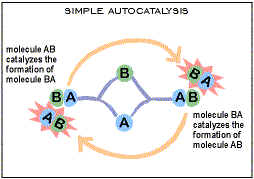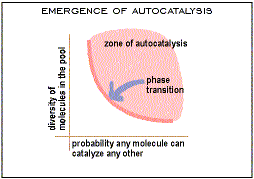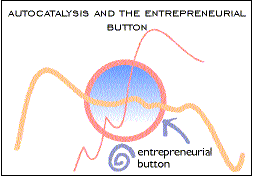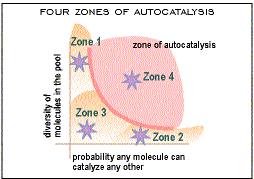|
 This
article summarizes Stuart Kauffman’s book At Home in the Universe.
All of the principles that are discussed concerning complex systems are
his, or if attributed to others, may be found in his book. The conclusions
drawn with respect to venture management and transition management in
organizations are a mixture of mine and Dr. Kauffman’s. The models
from the Taylor Modeling Language are copyrighted, of course, by MG Taylor
Corporation. This
article summarizes Stuart Kauffman’s book At Home in the Universe.
All of the principles that are discussed concerning complex systems are
his, or if attributed to others, may be found in his book. The conclusions
drawn with respect to venture management and transition management in
organizations are a mixture of mine and Dr. Kauffman’s. The models
from the Taylor Modeling Language are copyrighted, of course, by MG Taylor
Corporation.
Related Articles:
Part II: Requirements
for Order and Evolution on Fitness Landscapes
Part III: Coevolution
on Coupled Fitness Landscapes and Patch Theory
Since Newton, science has believed
in a deterministic, clockwork universe. Since Darwin, science has believed
that life advances or improves based on random mutations and natural selection.
Since Galileo, we've begun to fathom the immensity of space believing
that we are probably alone in it--that life is a random, improbable occurrence.
Now all of that is changing.
Quantum physics and chaos theory challenge
the belief that events are always deterministic. Complexity theory challenges
the view that natural selection alone suffices to explain evolution. Complexity
theory also suggests that we may be far from alone in the universe--that
the emergence of life is a very probable, natural phenomenon.
Is there an explanation for the order
that emerges in nature, from the arms of a spiral galaxy to the creation
of an enterprise?
Preface
Suppose we could discover the laws that support
the natural emergence of order and life in the universe.
What if the emergence and evolution of life were not predicated merely
upon random association and chance mutation? What if order in the universe
came for free? What if we understood these laws well enough to relate
them to our own enterprises? Stuart Kauffman believes he and others working
in the field of complexity have discovered such laws and that they may
well apply to our own enterprises and the transitions they make as well
as they do to molecular biology or computer simulation.
I recommend that you get a copy of At Home in the
Universe in order to get a purer synthesis and understanding of these
concepts and also to absorb much of the background and analysis which,
due to brevity, has been eliminated from the following discussion.
Thinking around complex systems is hotly contested in
the world of the physical sciences, and nothing has yet emerged that approximates
a theory. The concepts presented here remain unproved in the laboratory.
They have been demonstrated in sophisticated computer simulations, however.
And when they are corroborated with laboratory evidence, it will likely
be on the molecular level—at least to begin with. Therefore, as we
extrapolate these principles beyond the computer simulation, through molecular
dynamics and on up to the evolution of species, finally coming to rest
at the interaction of people in organizations, we are stretching our assumptions
and conclusions. Right now, these principles are food for thought, not
immutable truths. Still, they present a beautiful logic and the computer
simulations at least mimic much of what we see in our backyards and our
organizations. Because of this mimicry, we may find ourselves in the presence
of some fundamental laws.
Because every Knowledge Worker in our network is engaged
in the work of transition management (see the transition
manager’s creed for more information),
the more we understand about the nature of transitions in organizations,
the more insight we will bring to our tasks. And because MG Taylor is
itself such an organization, these insights should yield benefits to ourselves,
collectively, as well.
Contents
- Selection
Selection and self-organization as organizing principles in living systems
- Autocatalysis,
a process which allows complex systems to emerge naturally
Rules for bringing new ideas and enterprises to life
- Requirements
for order in emergent systems
Keeping things in control—and out of control
- The
evolution of living systems, using a tool called a fitness landscape
Evolution and innovation in the enterprise
- The
coevolution of living systems, using coupled fitness landscapes
Working with competitors and collaborators
- The
solution of hard, conflict-laden problems using patch theory
Managing complex, high-conflict problems in the enterprise
- Conclusion:
Implications for the Enterprise
Selection
"Sufficiently complex mixes of chemicals can spontaneously
crystallize into systems with the ability to collectively catalyze the
network of chemical reactions by which the molecules themselves are formed.
Such collectively autocatalytic sets sustain themselves and reproduce."
The biosphere generates order from two sources: selection
and self-organization. Selection is the process first described by Darwin
wherein organisms and organizations which better fit their environment
(the interplay with other species, geological and atmospheric chemistry)
have a better chance of passing their genes on to successive generations.
Random mutation, or mistakes, in the genetic code provides one source
of change from generation to generation in a species. Mating, or the sharing
of DNA provides the other source. The changes that allow an individual
to be more fit, tend to be reproduced.
But relying on random mutation and selection leaves us
with several perplexing problems. First, the principle of selection affords
no explanation for the origin of life. Second, the process of random mutation
works too slowly for life to use as an algorithm for rapidly searching
out better and better solutions for fitness. For example, if you consider
that human DNA has roughly 100,000 genes, and that in any given individual,
each gene could be either expressed (active) or repressed (inactive),
then the number of different manifestations or options for the genome
would be 2 raised to the power of 100,000. One of these configurations
is superior to all the rest. Imagine searching through a catalog of 2^100,000
strands of DNA in order to find this best one. There is not enough time
in the universe for humanity to search through even a tiny fraction of
these possibilities. And yet, organisms seem to discover marvelously adapted
expressions of their DNA over relatively short frames of time. How is
this possible?
Are there fundamental laws that allow for both the generation
of life and the rapid search of unthinkably large state spaces? There
must be. Otherwise, life is far too improbable an occurrence to have appeared
on even one planet in the universe. Perhaps the principles of complexity
may comprise or lead to such laws.
Autocatalysis
A reaction is a process by which substrates (atoms or molecules) combine
or split apart to form products. Hydrogen and oxygen combine to form water;
water can be decomposed to form hydrogen and oxygen gases.  The
accompanying diagram shows two molecules, A and B combining to form a
third molecule, AB. Ordinarily, reactions occur when different substrates
just happen to run into each other at the right angle and with the right
momentum to form a product. Left to themselves, most reactions occur very,
very slowly. The
accompanying diagram shows two molecules, A and B combining to form a
third molecule, AB. Ordinarily, reactions occur when different substrates
just happen to run into each other at the right angle and with the right
momentum to form a product. Left to themselves, most reactions occur very,
very slowly.
A catalyst plays a role as facilitator in reactions, dramatically
increasing the speed at which the reactions can occur. A catalyst binds
to the transition state in the reaction, stabilizes it and makes it easier
for the molecules to jump to the transition state. Usually a catalyst
is unaffected by the reaction, in that its composition is unchanged. Thus,
a single catalyst can aid in many, many reactions, unless it is catalyzed
itself in another reaction.
 An
autocatalytic set is a collection of molecules which catalyze each other’s
reactions—help bring each other into existence, so to speak. An extremely
simple example from the book is shown in an accompanying diagram. Consider
a pool of molecules, A and B which create two products, AB and BA. Understand
that the order in which molecules combine makes a difference, so AB is
truly a different molecule than BA, having different properties. If product
AB catalyzes (speeds up) the production of BA and BA catalyzes the production
of AB, then a bootstrapping phenomenon emerges. In the presence of a constant
supply of "food molecules" A and B, quantities of BA and AB
will rapidly appear. More AB and BA molecules beget even more of themselves.
The growth rate becomes exponential, obeying the cybernetic principle
of positive feedback. The system is no longer dead, but "alive."
It recreates itself. Once the first AB and BA molecules emerge, the cycle
heads off along the exponential growth curve. An
autocatalytic set is a collection of molecules which catalyze each other’s
reactions—help bring each other into existence, so to speak. An extremely
simple example from the book is shown in an accompanying diagram. Consider
a pool of molecules, A and B which create two products, AB and BA. Understand
that the order in which molecules combine makes a difference, so AB is
truly a different molecule than BA, having different properties. If product
AB catalyzes (speeds up) the production of BA and BA catalyzes the production
of AB, then a bootstrapping phenomenon emerges. In the presence of a constant
supply of "food molecules" A and B, quantities of BA and AB
will rapidly appear. More AB and BA molecules beget even more of themselves.
The growth rate becomes exponential, obeying the cybernetic principle
of positive feedback. The system is no longer dead, but "alive."
It recreates itself. Once the first AB and BA molecules emerge, the cycle
heads off along the exponential growth curve.
Notice that all of the nodes in this simple network get
connected up to one another in a web. In more complex webs, every node
is connected to every other node indirectly, through one another, and
the nature of that connection may be one of two kinds:
- indicating the creation of a product from one or more
nodes,
(the purple connection lines in the diagram above),
- indicating the influence of a catalyst on another reaction
(the pale yellow lines from the diagram).
There's only one problem. How do the first molecules AB
and BA emerge? And how likely are they to catalyze one another's production?
What's the origin of the order inherent in the autocatalytic set?
 Imagine
a pool of simple organic molecules. Some of the molecules will catalyze
reactions between other molecules. What are the chances that some of the
molecules will behave as catalysts? We don’t know, but Kauffman employs
some very conservative mathematics in his investigation. He assumes that
the probability a certain molecule catalyzes any given reaction is one
in a million. Even so, as the diversity of the molecules in the pool increases,
at some point an autocatalytic set emerges all by itself. That point is
a phase transition. Suddenly there's a shift from a simple pool of reacting
organic molecules to a pool of organic molecules, a small set of which
is now able to reproduce itself exponentially, given a requisite flow
of food molecules. Imagine
a pool of simple organic molecules. Some of the molecules will catalyze
reactions between other molecules. What are the chances that some of the
molecules will behave as catalysts? We don’t know, but Kauffman employs
some very conservative mathematics in his investigation. He assumes that
the probability a certain molecule catalyzes any given reaction is one
in a million. Even so, as the diversity of the molecules in the pool increases,
at some point an autocatalytic set emerges all by itself. That point is
a phase transition. Suddenly there's a shift from a simple pool of reacting
organic molecules to a pool of organic molecules, a small set of which
is now able to reproduce itself exponentially, given a requisite flow
of food molecules.
Autocatalysis depends then on at least two parameters:
- the diversity of molecules in the pool and
- the probability that a molecule will catalyze any other
reaction.
The preceding graph shows the relationship between these
two parameters. The curved line is the phase transition between a system
that is dead (on the left side of the line) and one that is alive (on
the right side of the line).
IMPLICATIONS FOR TRANSITION MANAGEMENT
These implications are only food for thought—not proven principles
of organizational dynamics. If we map what we’ve learned about autocatalysis
in computer simulations onto organizations, the following points stand
out.
Governing Factors:
- Requisite diversity in the nodes of the enterprise:
the mix of people and their interface with the 7
Domains (information, processes, education,
environments, technical systems, tools, projects, ventures)
- An ability for these nodes to catalyze or facilitate
each other's productivity
- Tuning the degree of diversity and facilitation can
yield "order for free."
Thoughts on Success and Failure of Startup Ventures:
- Hunting for the right combinations in diversity and
the collaboration of elements is very difficult. Finding and supporting
high performance teams with the right mix of the seven domains can seem
like hunting for that perfect DNA sequence, the proverbial needle in
the haystack.
- When an enterprise crosses the phase transition boundary
the state change may be instantaneous. One day everything is chaos,
the next it's all focused and driving toward success. We tend to look
for the added element that made the difference. In reality, it's the
mix as a whole that causes the system to go autocatalytic.
Other Comments:
Consider a small company starting out—inevitably
a company poised to enter the entrepreneurial
button.  Or
consider a new product line within an existing enterprise. Will it be
able to autocatalyze itself? In other words, will it become an entity
of its own, capable of separate existence? What governs its success?
Two factors: the laws of selection in the internal and external marketplace,
and the chance that the new system will reach the phase transition and
exhibit the features of self-organization. Or
consider a new product line within an existing enterprise. Will it be
able to autocatalyze itself? In other words, will it become an entity
of its own, capable of separate existence? What governs its success?
Two factors: the laws of selection in the internal and external marketplace,
and the chance that the new system will reach the phase transition and
exhibit the features of self-organization.
The enterprise is composed of nodes (or "molecules").
Some of these are represented by people, others by artifacts, tools
and products. These nodes represent some degree of diversity and they
also have some greater or lesser ability to catalyze each other. We
have to think a bit about what this might mean in an organization.
Diversity is a fairly easy concept to imagine in an
organization. We could produce a list of elements that any given organization
should have in order to be successful. Certainly there must be knowledge
about the product and how it is made, some pathways into a marketplace
for sales and distribution, some skills of leadership, and so on. We
have an intuitive sense that there is some threshold of diversity of
information, roles, ideas, and tools below which, the creation of an
enterprise becomes very difficult, if not impossible.
It's a little more difficult, but not much more, to
imagine how these different elements do or don't catalyze each other.
For example, if the team of people comprising the young enterprise do
not or cannot communicate information that makes each other's tasks
easier and clearer, chances of that enterprise succeeding are slim.
If tools and equipment can be made to serve several functions in the
manufacturing process, through the use of interchangeable parts, they
are better catalysts. Consider a drill press without the ability to
change the size of the bit as an example of a tool that does not facilitate
work. In some organizations, desktop computers facilitate or catalyze
work, in others, they're mostly expensive typewriters.
Some organizations encourage the participation of their
employees and some do not. Another look at the phase transition diagram
may offer a clue as to why this is so. If an organization is characterized
by very high diversity of components, then it is not necessary to have
much catalysis between components. On the other hand, if the diversity
of components is smaller, then more catalysis is necessary--each component
must have the capacity or ability to facilitate the work of other components.
The autocatalysis phase transition diagram may therefore be divided
into four zones; three zones of failure, and one of success.  Zone
1 represents failure characterized by more than sufficient diversity
of ideas, people, tools, and processes, but a deficit of meaningful,
catalyzing connections between the nodes in this diversity. Zone 2 fails
in the opposite manner--a high rate of catalysis (so high, in fact that
the nodes in the network can never settle down to a single set of high
value states) among a non-diverse set of nodes. Imagine the kind of
company that only hires its own types of people and sets too rigid standards
on the use of equipment and computers. There may be lots of people and
lots of equipment in the equation, but they all behave the same--there's
no true diversity. Zone
1 represents failure characterized by more than sufficient diversity
of ideas, people, tools, and processes, but a deficit of meaningful,
catalyzing connections between the nodes in this diversity. Zone 2 fails
in the opposite manner--a high rate of catalysis (so high, in fact that
the nodes in the network can never settle down to a single set of high
value states) among a non-diverse set of nodes. Imagine the kind of
company that only hires its own types of people and sets too rigid standards
on the use of equipment and computers. There may be lots of people and
lots of equipment in the equation, but they all behave the same--there's
no true diversity.
Zone 3 represents the type of failure experienced by many start-ups:
too little diversity and too little ability of the nodes to catalyze
each other's work. There's not enough overlap between individual experiences,
for example, to allow people in the organization to anticipate one another's
actions, take up each other's slack, or collaborate creatively.
 Zone
4 represents a whole universe right mixes of diversity and catalytic
probability. Getting to Zone 4 is what pushing the entrepreneurial button
is all about. The Success Zone
4 represents a whole universe right mixes of diversity and catalytic
probability. Getting to Zone 4 is what pushing the entrepreneurial button
is all about. The Success  zone in the Stages of an Enterprise Model represents the crossing of
the autocatalytic phase transition.
zone in the Stages of an Enterprise Model represents the crossing of
the autocatalytic phase transition.
So as transition managers helping companies steer themselves
into birth or rebirth, it's helpful to understand this relationship between
diversity, catalysis, and the phase transition of autocatalysis between
life and death. In terms of our own Business
of Enterprise model, we can begin to see the
importance of the relative sizes of the four components of the model,
the nature and density of the connections between nodes in the network,
and how much of the model the management function encompasses. We tend
to draw this model in a stereotyped way but if we examine it deeply from
the vantage point of complex systems, we will begin to draw it with more
intention and understanding.

concepts concerning complex adaptive
systems come from Stuart Kauffman's book At Home in the
Universe, 1995, Oxford University Press
application to organizational theory copyright © 1997, MG Taylor Corporation.
All rights reserved
copyrights,
terms and conditions
19970701145538.web.bsc |

